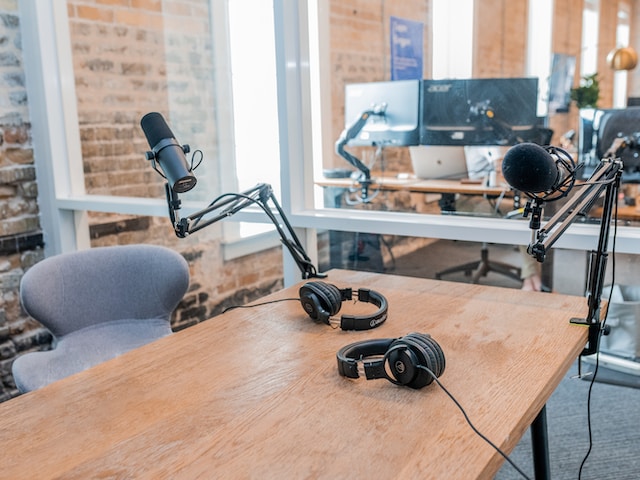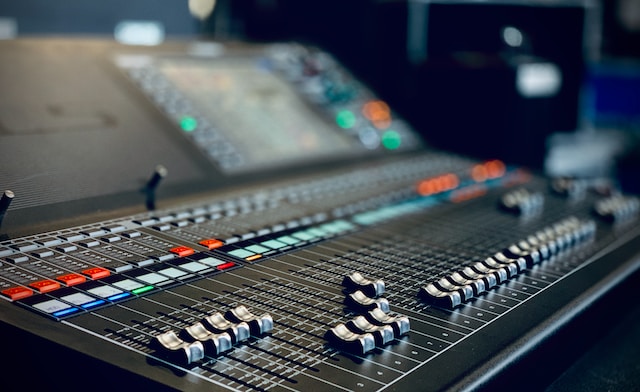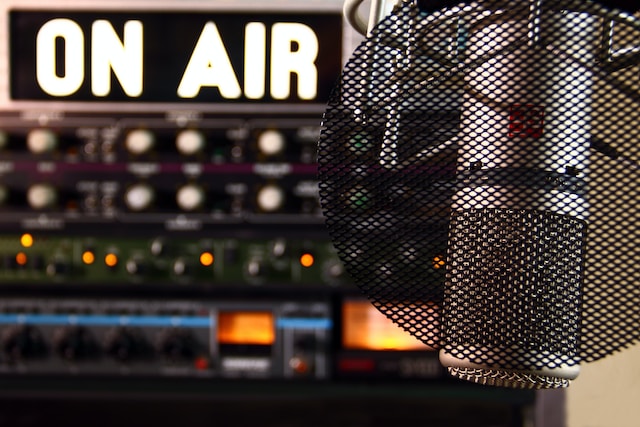Podcasts offer a more niche-specific approach that allows for on-demand listening at any time. They also provide an opportunity for individuals or small businesses to create content without the need for expensive equipment or broadcasting licenses. Broadcasts, on the other hand, have a wider reach as they can be accessed by anyone with access to radio or television. They also tend to cover broader topics that appeal to a larger audience.
What is a podcast?
(Photo by Austin Distel on Unsplash )

A podcast is a digital audio file that can be downloaded and streamed online. It’s essentially an on-demand radio show that you can listen to anywhere, anytime. Unlike traditional radio shows, podcasts are not live broadcasts – they’re pre-recorded episodes which can range from short-form news updates to long-form interviews or storytelling pieces.
Typically, podcasts are released in a series format with new episodes being added regularly. Listeners can subscribe to their favorite podcasts so that any new episode will automatically download onto their device as soon as it’s available.
One of the biggest appeals of podcasting is its accessibility – all you need is an internet connection and a compatible device like your phone or laptop. Plus, there’s no need to tune into a specific station at a specific time since you have complete control over when and where you listen.
Podcasting has become increasingly popular in recent years due to its convenience and ability to cover niche topics that might not get airtime on traditional media outlets. It offers listeners the opportunity to learn about anything from politics and pop culture trends, health tips, personal finance advice or cooking hacks – the possibilities are endless!
What is a broadcast?
(Photo by Alberto Duo on Unsplash )

A broadcast is a method of transmitting audio or video content to the public through various mediums, such as television or radio. This form of media has been around for over a century and continues to be widely used today.
Broadcasts can be live or pre-recorded and are typically transmitted through airwaves using frequencies that are picked up by electronic devices, such as TVs and radios. The content broadcasted can range from news updates to entertainment shows, sports events, music concerts, and more.
The process of creating a broadcast involves a team of professionals who work together to produce high-quality content that is engaging for the audience. This includes writers, producers, camera operators, sound engineers, directors and presenters.
One disadvantage of broadcasts is their limited interactivity with audiences. Unlike podcasts where listeners can engage with hosts directly through comments or feedback sections online; broadcasts do not provide this opportunity in real-time. However, broadcasters may interact with their audience via social media after the show has aired.
Broadcasting remains an essential part of today’s media landscape offering instant access to relevant information across large geographical areas at once while providing opportunities for advertisers seeking broad reach campaigns.
Podcast Vs. Broadcast – Key differences
Podcasts and broadcasts are two different forms of media, with distinct characteristics that set them apart. While both involve the sharing of information or entertainment to an audience, there are some key differences between these two mediums.
One main difference is in their delivery method. Broadcasts are delivered over traditional radio or television airwaves, while podcasts are distributed online through various platforms such as iTunes and Spotify.
Another difference lies in their production process. Broadcasts typically require a studio setup with professional equipment and staff to produce live content on a scheduled basis. Podcasts can be recorded anywhere at any time using basic recording tools like a smartphone or laptop.
Furthermore, the audiences for each medium differ greatly as well. Broadcast audiences tend to be more general and localised whereas podcast listeners tend to be niche-specific and globalised.
It’s important to note that although podcasts lack the immediacy of live broadcasts they do have greater flexibility when it comes to length and content format compared with broadcast which has defined timeslots allocated by TV networks & Radio stations
In summary, while both podcasting and broadcasting share similarities in terms of delivering audio content; they differ significantly in terms of distribution methods,time flexibility,content format, and target audience size & range
How to start a podcast
Starting a podcast can be an exciting endeavor, but it’s essential to have the right tools and mindset to get started. Here are some tips on how to start a podcast:
- Identify your niche: Determine what you want your podcast to focus on and who your target audience is.
- Choose the format: Decide if you want solo episodes or interviews with guests. Consider scripted versus unscripted content.
- Get equipment: Invest in quality microphones, headphones, and recording software for better sound quality.
- Plan out episodes: Create outlines or scripts for each episode before recording.
- Record and edit: Find a quiet space with minimal background noise, record your episodes then go back through them later to edit any mistakes or unnecessary parts of the audio file.
Publish and promote: Once you’re satisfied with each episode’s final cut, publish it online using hosting platforms like Buzzsprout or Anchor.fm while also promoting it on social media channels such as Twitter, Instagram etc.
Remember that consistency is key when starting a podcast so make sure you set up an achievable publishing schedule that fits into your lifestyle!
How to start a broadcast
Starting a broadcast can be a thrilling experience, but it requires careful planning and preparation. Here are some tips to help you get started:
- Identify your audience: Before starting your broadcast, determine who your target audience is. This will help you create content that resonates with them.
- Choose the right platform: There are many platforms available for broadcasting, such as television or radio stations. Choose the one that aligns with your goals and budget.
- Invest in equipment: High-quality equipment is essential for producing professional broadcasts. Consider investing in cameras, microphones, lighting, and editing software.
- Develop engaging content: Your content should be informative, relevant to your audience’s interests and entertaining enough to keep them engaged throughout the entire show.
- Practice makes perfect: Practice before going live helps eliminate technical issues during broadcasting shows
- Promote your broadcasts on social media platforms where most of your target audiences hangout
Remember that starting a successful broadcast takes time and effort but if done correctly it could become an exciting career opportunity!
Advantages and disadvantages of Podcasts
Podcasts have rapidly gained popularity in recent years as a form of audio entertainment and education. They offer numerous advantages over traditional forms of media, but like any medium, they also come with their own drawbacks.
One major advantage of podcasts is convenience. You can listen to them on your own schedule and from anywhere you want- whether it’s during your daily commute or while doing household chores. Additionally, podcasts are often free to download or stream online, making them an affordable option for listeners.
Another benefit is the sheer variety available. There are podcasts covering nearly every topic imaginable – from true crime stories to sports commentary – ensuring that there’s something for everyone.
However, one disadvantage is that podcast production quality can vary widely depending on the creator’s technical skills and equipment used. Some shows may sound professional while others might be difficult to hear due to poor audio quality.
Moreover, since podcasts tend to lack visual content unless specifically produced as video-based shows (vlogs), they may not appeal as much visually-oriented audiences who prefer images or videos alongside audio cues.
Despite its limitations in terms of multimedia content and varying production quality among creators; Podcasts remain a popular way of consuming information and entertainment thanks for their versatility and availability across multiple platforms without being restricted by location or timing constraints.
Advantages and disadvantages of Broadcasts
Broadcasts, whether on the radio or television, have been around for almost a century and they still hold their position as one of the most popular forms of media. Here are some advantages and disadvantages to consider:
Firstly, broadcasts reach a wide audience with minimal effort. Unlike podcasts that need promotion and advertising to gain listenership, broadcasts already have an established audience who tune in regularly. Secondly, since broadcasters can reach large audiences simultaneously, it is ideal for important events like political campaigns or breaking news stories.
One disadvantage is lack of control over content. Broadcasters must adhere to strict regulations regarding what they air which can stifle creativity and freedom of speech. Another disadvantage is limited interaction with the audience due to its one-way communication nature; unlike podcasts where feedback from listeners is common.
While there are limitations associated with broadcasting mediums it remains an effective way to disseminate information quickly across broad demographics without requiring significant marketing efforts.
Featured Image By – Fringer Cat on Unsplash








